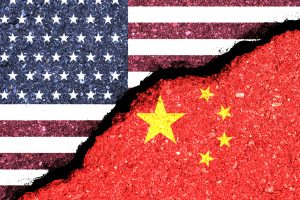Sara Hsu

As the United States and China move closer to direct conflict, the stakes have been thrown into stark relief. Putting aside the humanitarian impacts – which would be devastating – the costs of a China-U.S. conflict for global supply chains alone would be very high due to strong interconnectedness between the two nations, and among the two nations and the rest of the world. The potential disruption of trade routes, loss of productive industries, and reduced foreign investment would result in rising costs and complexity for multinational businesses.
First, consider the impact of a China-U.S. direct conflict on trade routes. A conflict might result in naval blockades or restricted access to strategic shipping lanes, particularly in the South China Sea. Ports may be disrupted as well. Such disruptions would raise transportation costs, delay shipments, and cause shortages of goods. Insurance companies would raise premiums due to a heightened risk of conflict, piracy, or other security threats in the region.
Second, a direct conflict would result in a loss of production capacity due to direct damage to infrastructure, labor disruptions, and reduced access to energy and other resources. Because the United States and China are major manufacturing hubs, reduced production capacity in both countries would lead to a global shortage of goods and higher prices.
Dependent industries would be among the impacted sectors. Many industries, such as electronics, automotive, and pharmaceuticals, are heavily reliant on components and raw materials from both the United States and China. We have already witnessed a negative impact on dependent industries, including electronics, automotive, agriculture, and machinery, resulting from the China-U.S. trade war. Tariffs imposed on imports and exports led to supply chain disruptions, increased costs, and reduced demand for certain products. Companies in these industries had to adapt by finding alternative suppliers, adjusting pricing strategies, or passing on increased costs to consumers.
Third, a direct conflict would increase costs for businesses. Companies with supply chain operations in the United States and China would face higher costs due to tariffs, import/export restrictions, loss of productive capacity, and labor or supply shortages. As we have witnessed during the China-U.S. trade war, tariffs increased the cost of imports and exports, which in turn led to higher costs for businesses that rely on components, raw materials, or finished products from either country. Some businesses absorbed these increased costs, while others passed them on to consumers in the form of higher prices. In a direct conflict, additional costs stemming from transportation delays, currency fluctuations, and supply chain relocations are likely to occur.
Finally, China-U.S. conflict will result in reduced direct foreign investment as investors fear instability and escalation. In particular, U.S. and other multinational firms that have based production and assembly in China for many years will face extensive interruptions and will need to pivot to more stable and profitable regions of the world. This phenomenon will contribute to rising production costs as firms divest from China and invest elsewhere.
The impacts above are just some of the literal economic disruptions that a China-U.S. conflict would cause. Estimates range from hundreds of billions to trillions of dollars. The actual cost would depend on the severity, duration, and specific circumstances of the conflict.
The question is, why continue to escalate a conflict that will have a devastating impact on the world? Is it necessary to go through the pain of direct confrontation in order to arrive at a new equilibrium? Do we still live in a world where the win-lose relationship is the reigning standard?
There are ways to deescalate this conflict. It will take time and a rebuilding of trust, but it is critical for global peace and stability. The first way is through dialogue and diplomacy. Encouraging open and continuous dialogue between the United States and China at various levels, including high-level summits, ministerial meetings, and working-level talks can address misunderstandings and allow countries to air grievances. Strong working mechanisms to address the contentious issues between the two countries must be established.
It may be necessary to involve third-party organizations to help resolve disputes. Track II diplomacy among non-governmental actors, such as think tanks, academics, and former officials, should continue to function in order to explore potential areas of cooperation and generate ideas for resolving disputes.
Ongoing economic ties should be reinforced as dialogue improves. Critically, growth in areas of contention, such as certain technologies, should not be encouraged until the issues are resolved. It may be the case that the United States and China mutually agree to decouple in sectors that are critical to national security for both nations, especially if the two countries have different understanding of the rules of the game. However, in other industries the U.S. and China have cooperated well in the past and may do so into the future if there are no further hindrances.
Given the geopolitical climate, it is likely that any calls for de-escalation will be met with cynicism or even contempt. At the rate the China-U.S. conflict is escalating, however, many Americans predict that direct conflict is on the horizon, and this will bring poverty, pain, and loss. We must take all measures to avoid this likely scenario and work toward a geopolitical stance based on mutual benefit and coexistence where possible.
No comments:
Post a Comment